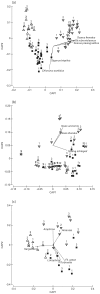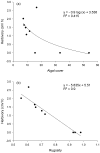Spatial patterns in herbivory on a coral reef are influenced by structural complexity but not by algal traits
- PMID: 21347254
- PMCID: PMC3037963
- DOI: 10.1371/journal.pone.0017115
Spatial patterns in herbivory on a coral reef are influenced by structural complexity but not by algal traits
Abstract
Background: Patterns of herbivory can alter the spatial structure of ecosystems, with important consequences for ecosystem functions and biodiversity. While the factors that drive spatial patterns in herbivory in terrestrial systems are well established, comparatively less is known about what influences the distribution of herbivory in coral reefs.
Methodology and principal findings: We quantified spatial patterns of macroalgal consumption in a cross-section of Ningaloo Reef (Western Australia). We used a combination of descriptive and experimental approaches to assess the influence of multiple macroalgal traits and structural complexity in establishing the observed spatial patterns in macroalgal herbivory, and to identify potential feedback mechanisms between herbivory and macroalgal nutritional quality. Spatial patterns in macroalgal consumption were best explained by differences in structural complexity among habitats. The biomass of herbivorous fish, and rates of herbivory were always greater in the structurally-complex coral-dominated outer reef and reef flat habitats, which were also characterised by high biomass of herbivorous fish, low cover and biomass of macroalgae and the presence of unpalatable algae species. Macroalgal consumption decreased to undetectable levels within 75 m of structurally-complex reef habitat, and algae were most abundant in the structurally-simple lagoon habitats, which were also characterised by the presence of the most palatable algae species. In contrast to terrestrial ecosystems, herbivory patterns were not influenced by the distribution, productivity or nutritional quality of resources (macroalgae), and we found no evidence of a positive feedback between macroalgal consumption and the nitrogen content of algae.
Significance: This study highlights the importance of seascape-scale patterns in structural complexity in determining spatial patterns of macroalgal consumption by fish. Given the importance of herbivory in maintaining the ability of coral reefs to reorganise and retain ecosystem functions following disturbance, structural complexity emerges as a critical feature that is essential for the healthy functioning of these ecosystems.
Conflict of interest statement
Figures






References
-
- Pickett STA, Cadenasso ML. Landscape ecology - Spatial heterogeneity in ecological systems. Science. 1995;269:331–334. - PubMed
-
- Augustine DJ, McNaughton SJ. Ungulate effects on the functional species composition of plant communities: Herbivore selectivity and plant tolerance. J Wildl Manage. 1998;62:1165–1183.
-
- Augustine DJ, Frank DA. Effects of migratory grazers on spatial heterogeneity of soil nitrogen properties in a grassland ecosystem. Ecology. 2001;82:3149–3162.
-
- Milchunas DG, Lauenroth WK. Quantitative effects of grazing on vegetation and soils over a global range of environments. Ecol Monogr. 1993;63:327–366.
-
- Hulme PE. Herbivory, plant regeneration, and species coexistence. J Ecol. 1996;84:609–615.
Publication types
MeSH terms
LinkOut - more resources
Full Text Sources

